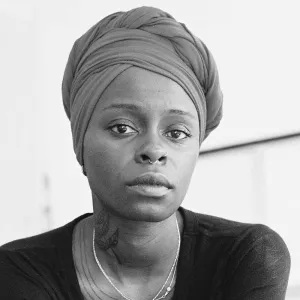Previously on View: Toyin Ojih Odutola
[[{"fid":"55566","view_mode":"default","fields":{"format":"default","field_file_image_alt_text[und][0][value]":"charcoal pastel and chalk depiction of seated woman with staff at elbow","field_file_image_title_text[und][0][value]":false},"type":"media","field_deltas":{"1":{"format":"default","field_file_image_alt_text[und][0][value]":"charcoal pastel and chalk depiction of seated woman with staff at elbow","field_file_image_title_text[und][0][value]":false}},"attributes":{"alt":"charcoal pastel and chalk depiction of seated woman with staff at elbow","style":"height: 509px; width: 300px; float: left;","class":"media-element media-element pr-3 pb-2 file-default","data-delta":"1"}}]]Toyin Ojih Odutola (b. Ile-Ife, Nigeria, 1985)
The Listener, 2021
Charcoal, pastel, and chalk on linen over Dibond panel
84 x 50 x 1 3/8 inches
© Toyin Ojih Odutola
Courtesy of the artist and Jack Shainman Gallery, New York
Ojih Odutola’s The Listener is part of a series of drawings that chronicle a prehistoric civilization envisioned by the artist. Here, the ruling class of queer female warriors, the Eshu, dominate the Koba, a serving class of male laborers. The drawings are presented as remains of this imagined civilization, as printed scans of fragile rock tablets unearthed in an archaeological dig in central Nigeria. In this fictive realm, the traditional relationships codified in historic European art are inverted. Heterosexuality is aberrant, homosexuality is compulsory, and women rule men.
Ojih Odutola’s mythical subject draws attention to Old Master fictions. Rembrandt’s Self-Portrait, for example, is the largest and most magisterial of the artist’s many self-portraits. He appears as if he is enthroned with a scepter-like staff, yet the artist was destitute when he painted it. Seated informally but without conceding authority, her own staff at the crook of her elbow, Ojih Odutola’s subject is from an imagined past. In both works, hands figure prominently—evoking the hands of the artists who applied their media, nearly four centuries apart. The comparison emphasizes the differences of their materials—Rembrandt’s thickly painted oils on canvas versus Ojih Odutola’s drawn charcoal, pastel, and chalk, each leaving their distinctive traces in laboriously applied marks. Through medium and technique, the artists offer disparate approaches to skin, color, form, and shadow. On the black ground of the drawing’s support, the figure in The Listener peers out at the viewer, the force of her sparkling eyes prompting reflection on myth and history, selfhood and identity, and the power and privilege to create one’s own story.
The Listener temporarily takes the place of Rembrandt’s Polish Rider which is currently on loan to the exhibition The King’s Rembrandt at Wawel Castle: The Polish Rider from the Frick Collection in New York at The Wawel Royal Castle – State Art Collection, Krakow.
View full Frick Madison Virtual Tour
About the Artist

Toyin Ojih Odutola (b. Ile-Ife, Nigeria, 1985) is known for works on paper that explore the malleability of identity and possibilities in visual storytelling. Interested in “the topography of skin,” she has a distinctive style of mark making using basic drawing materials, such as pens, pencils, pastels, and charcoal. This technique involves the building up of layers through blending and shading, creating compositions that reinvent and reinterpret the traditions of portraiture. Ojih Odutola credits the development of her style to using pen, which, as a writing tool, links her work to fiction in crafted narratives that unfold through series of artworks like the chapters of a book. Her work is inspired by both art history and popular culture, as well as her own personal history—from her birth in Nigeria to her childhood move to America, where she was raised in conservative Alabama. In more recent series, she has explored depictions of landscapes, architecture, and domestic interiors. Ojih Odutola’s work has been presented in several shows at Jack Shainman Gallery; her first solo museum exhibition in New York, To Wander Determined, was held at the Whitney Museum of American Art in 2017–18. In late 2020, London’s Barbican Centre presented A Countervailing Theory, which traveled in the spring of 2021 to the Kunsten Museum of Modern Art in Aalborg, Denmark. The installation is on view at the Hirshhorn Museum in Washington, D.C., through April 3, 2022.
Photo: Beth Wilkinson
#ToyinOjihOdutola

